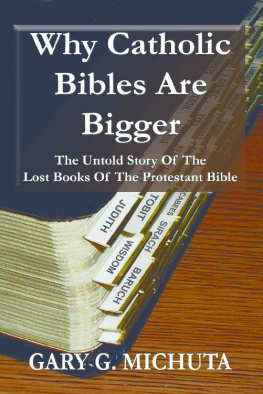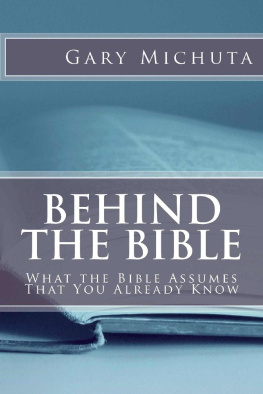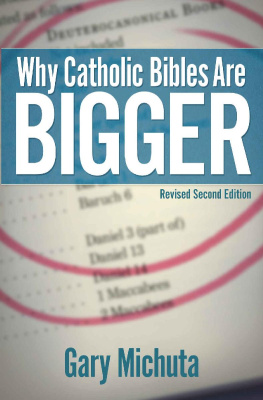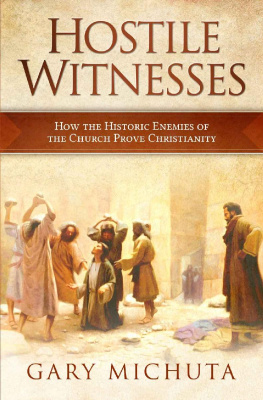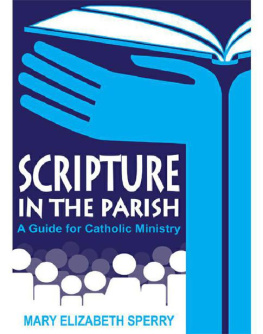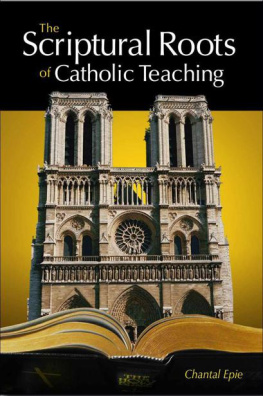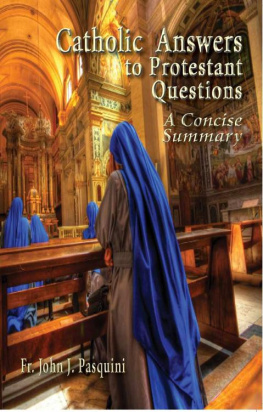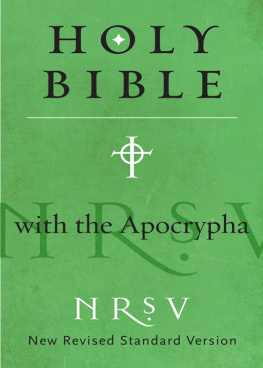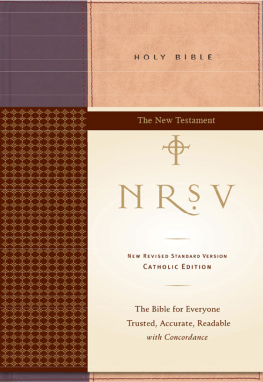Why Catholic Bibles Are Bigger
By Gary Michuta
More material from
Gary Michuta
www.handsonapologetics.com
Except where otherwise indicated, all Scripture quotations in this book are takenfrom the New American Bible with Revised New Testament and Revised Psalms 1991, 1986, 1970 Confraternity of Christian Doctrine, Washington, DC, and areused by permission of the copyright owner. All Rights Reserved. No part of the NewAmerican Bible may be reproduced in any form without permission in writingfrom the copyright owner.
Scripture quotations taken from the New American StandardBible, Copyright 1960, 1962, 1963, 1968, 1971, 1972, 1973,1975, 1977, 1995 by The Lockman Foundation (www.Lockman.org). Used withpermission.
Quotations taken from Bruce M. Metzgers, An Introductionto the Apocrypha Oxford University Press, Inc., 198 MadisonAvenue, New York, New York 10016. Used with permission.
Quotations from Theological Dictionary of the NewTestament 1967 by Wm. B. Eerdmans Publishing Company, GrandRapids, Michigan. Gerhard Fridrich, ed., and Geoffrey W. Bromley, trans. anded. Used with permission.
Quotations from The Apocrypha In Ecumenical PerspectiveUBSMS 6 1991 by United Bible Societies. Used with permission.
WHY CATHOLIC BIBLES ARE BIGGER
2007 by Gary G. Michuta. All rights reserved
Published by The Grotto Press, Port Huron, Michigan877-247-6886
www.GrottoPress.org
Printed in the United States of America
Library of Congress Cataloguing-in-Publication Data
Michuta, Gary G., 1964
Why Catholic Bibles Are Bigger / Gary G. Michuta
Includes bibliographical references
ISBN 1-58188-010-3
978-1-58188-010-6
Contents
Acknowledgements
Amico fideli nulla est comparatio, et non est dignaponderatio auri et argenti contra bonitatem fidei illius. (Sir 6:15)
There are a number of people I would like to acknowledge andthank for bringing this book to completion. First and foremost, I would like tothank the Holy Spirit who has spoken through the prophets and gave us theSacred Scriptures as a treasure of His love and wisdom. Thank you Rod Bennettwho patiently worked through this book and made it warm, accessible andreadable for all. I would also like to thank the team of editors proofreadersand designers who help turn this book from research to a reality especiallyDennis Walters, Adele Brinkley, Gigi Mills, Brenda Polk, and Launa and AlanWakenhut. Thank you also Paul, Cassandra and the rest of the Husak family forthe gift of your time, wisdom and support for this project. My gratitude isalso extended to the team at Grotto Press for their flexibility and hard workespecially Diane Everett and John McAlpine. To my good friend Rob Corzine,whose constant advice and encouragement has guided me through the entiredevelopment of this book, I give thanks. Many thanks go to Douglas Eiben forspending hours in front of a hot photocopier. I owe Steve Ray and PatrickMadrid a very large debt of gratitude for their constant support and guidance.They have been faithful friends indeed. Finally, I would like to thank my wifeChris, and my children, Paulina, Daniel, and Jennifer for their patience andunderstanding while I was running off to libraries.
Abbreviations
ABD Anchor BibleDictionary
ANF Ante-Nicene Fathers(Robertson)
CBQ Catholic BiblicalQuarterly
CE Catholic Encyclopedia (1914 ed.)
D Sources of Catholic Doctrine (Denzinger)
DS Denzinger-Schonmetzer, Enchiridion Symbolorum
EJ Encyclopaedia Judaica.
FEF Faith ofthe Early Fathers
HTR Harvard TheologicalReview
IBD Interpreter Bible Dictionary
IJA International Journal of the Apocrypha
JBC JeromeBiblical Commentary
JTS Journal of Theological Studies
JBR Journalof Biblical Religion
NCC New CatholicCommentary on Holy Scripture
TDNT Theological Dictionary of theNew Testament
PG Patrologia Graecae (Migne)
PL Patrologia Latina (Migne)
Chapter 1 A Closed Pre-Christian Canon?
Is it true that the Old Testament canon was complete and closedlong before the first word of the Deuterocanon was written? Does the NewTestament provide evidence for a closed Old Testament canon? Do theDeuterocanonical books themselves contain proofs of this supposed fact?
All of these claims have been made through the years byProtestant apologists attempting to defend the canon of Luther and Calvin; andif any of these allegations were, in fact, proved valid then there really mightbe good reason to question the traditional Christian bible overthrown by Protestantism.These claims, however, are not truea fact that may be firmly established by acareful and unbiased examination of the historical record and the otherevidence at hand. Any bible-loving Christian will want to make such anexamination, surely, rather than run the risk of spurning a set of books whichmay, in fact, contain Gods own holy Word.
Let us begin by examining the claim that theDeuterocanonical books themselves provide evidence for a closed, pre-existingHebrew canon.
The Book of Sirach (200150 BC)
The Book of Sirach (also called Ecclesiasticus)is the oldest of the Deuteros, written in Hebrew (most likely in Palestine)sometime around the beginning of the second century before Christ. This grandson also addeda Greek preface to the book which refers several times to the existingScriptures of that day. Does this preface show, as some have claimed, that thecanon was already closed by then and excluded, therefore, Sirach itself?
Some Protestant apologists have argued that thisintroduction speaks of the Law, the Prophets, and the Writingsa three-folddivision of the Old Testament corresponding to the three-fold division inmodern Jewish bibles (Hat-Torah, Nebiim, wa-Kthubim)and implying thatthis same modern division was already present when Sirach (oldest of theDeuteros) was new. Unfortunately, this line of reasoning greatly overstates theevidence. Sirachs introduction never speaks of the Law, the Prophets and theWritings; it speaks only of the Law, the Prophets, and the other booksavery unusual piece of language if the now-established terms were already inuse. Indeed, in three attempts to reference Scripture in this fashion, Sirachsgrandson fails even once to apply what later became the recognized phraseology. Furthermore, such avery vague name as the other books may suggest a deliberate vaguenessand, in fact, recalls the similar ambiguity employed by some of the earlyChurch Fathers in the decades before a universally recognized New Testamentcanon was promulgated. At the very least, such an indistinct category cannot besaid to effectively exclude much of anything.
Moreover, in at least two places, perhaps more, Sirachindicates that he did, in fact, believe his book to contain the wisdom thatcomes only from the Lord, and that it could take a place among the other booksof Scripture (Sir Preface, Sir 24:28-31; cf. Sir 1:1; 6:37; 16:24-25;). These claims bear witnessto the fact that Sirach and his grandson, along with their contemporaries inPalestine and Egypt, could not have believed that the contents of Scripturewere yet fixed and/or that the composition of inspired literature was no longerpossible. After all, all of todays Christians are fully agreed that there wasdefinitely a great deal of Scripture yet to come in Sirachs timetwenty-twowhole books of New Testament writing! The idea that Sirachs introductionimplies a closed canon by 200 BC really implies that the canon of Scripture wasclosed once, then reopened in apostolic times, before being re-closedagain at the death of the Apostle John; an inelegant picture of Gods planof revelation to say the least.

